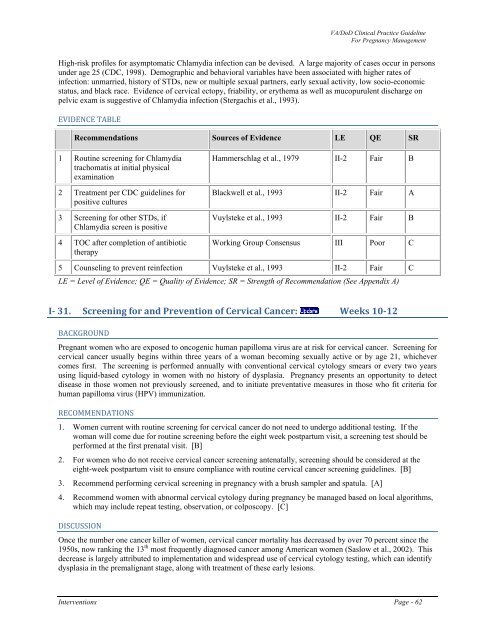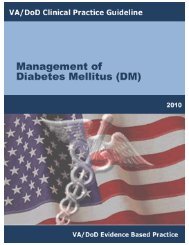Management of pregnancy - VA/DoD Clinical Practice Guidelines ...
Management of pregnancy - VA/DoD Clinical Practice Guidelines ...
Management of pregnancy - VA/DoD Clinical Practice Guidelines ...
You also want an ePaper? Increase the reach of your titles
YUMPU automatically turns print PDFs into web optimized ePapers that Google loves.
<strong>VA</strong>/<strong>DoD</strong> <strong>Clinical</strong> <strong>Practice</strong> Guideline<br />
For Pregnancy <strong>Management</strong><br />
High-risk pr<strong>of</strong>iles for asymptomatic Chlamydia infection can be devised. A large majority <strong>of</strong> cases occur in persons<br />
under age 25 (CDC, 1998). Demographic and behavioral variables have been associated with higher rates <strong>of</strong><br />
infection: unmarried, history <strong>of</strong> STDs, new or multiple sexual partners, early sexual activity, low socio-economic<br />
status, and black race. Evidence <strong>of</strong> cervical ectopy, friability, or erythema as well as mucopurulent discharge on<br />
pelvic exam is suggestive <strong>of</strong> Chlamydia infection (Stergachis et al., 1993).<br />
EVIDENCE TABLE<br />
Recommendations Sources <strong>of</strong> Evidence LE QE SR<br />
1 Routine screening for Chlamydia<br />
trachomatis at initial physical<br />
examination<br />
2 Treatment per CDC guidelines for<br />
positive cultures<br />
3 Screening for other STDs, if<br />
Chlamydia screen is positive<br />
4 TOC after completion <strong>of</strong> antibiotic<br />
therapy<br />
Hammerschlag et al., 1979 II-2 Fair B<br />
Blackwell et al., 1993 II-2 Fair A<br />
Vuylsteke et al., 1993 II-2 Fair B<br />
Working Group Consensus III Poor C<br />
5 Counseling to prevent reinfection Vuylsteke et al., 1993 II-2 Fair C<br />
LE = Level <strong>of</strong> Evidence; QE = Quality <strong>of</strong> Evidence; SR = Strength <strong>of</strong> Recommendation (See Appendix A)<br />
I 31. Screening for and Prevention <strong>of</strong> Cervical Cancer: Weeks 1012<br />
BACKGROUND<br />
Pregnant women who are exposed to oncogenic human papilloma virus are at risk for cervical cancer. Screening for<br />
cervical cancer usually begins within three years <strong>of</strong> a woman becoming sexually active or by age 21, whichever<br />
comes first. The screening is performed annually with conventional cervical cytology smears or every two years<br />
using liquid-based cytology in women with no history <strong>of</strong> dysplasia. Pregnancy presents an opportunity to detect<br />
disease in those women not previously screened, and to initiate preventative measures in those who fit criteria for<br />
human papilloma virus (HPV) immunization.<br />
RECOMMENDATIONS<br />
1. Women current with routine screening for cervical cancer do not need to undergo additional testing. If the<br />
woman will come due for routine screening before the eight week postpartum visit, a screening test should be<br />
performed at the first prenatal visit. [B]<br />
2. For women who do not receive cervical cancer screening antenatally, screening should be considered at the<br />
eight-week postpartum visit to ensure compliance with routine cervical cancer screening guidelines. [B]<br />
3. Recommend performing cervical screening in <strong>pregnancy</strong> with a brush sampler and spatula. [A]<br />
4. Recommend women with abnormal cervical cytology during <strong>pregnancy</strong> be managed based on local algorithms,<br />
which may include repeat testing, observation, or colposcopy. [C]<br />
DISCUSSION<br />
Once the number one cancer killer <strong>of</strong> women, cervical cancer mortality has decreased by over 70 percent since the<br />
1950s, now ranking the 13 th most frequently diagnosed cancer among American women (Saslow et al., 2002). This<br />
decrease is largely attributed to implementation and widespread use <strong>of</strong> cervical cytology testing, which can identify<br />
dysplasia in the premalignant stage, along with treatment <strong>of</strong> these early lesions.<br />
Interventions Page - 62
















